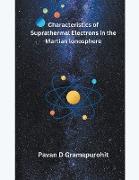- Start
- Characteristics of Suprathermal Electrons in the Martian Ionosphere
Characteristics of Suprathermal Electrons in the Martian Ionosphere
Angebote / Angebote:
The red planet in the night sky has always been attracting human attention from ancient times of visual observations with the naked eye to the modern era of spacecraft measurements. The Martian atmosphere is characterized by variations in its atmospheric composition and thermal structure, as observed across its lower and upper regions. The formation of the ionosphere along with the vertical profiles of ions and electrons, sets the plasma environment of Mars.
Mars is about half the size of Earth by diameter and the acceleration due to gravity on Mars is 40% lesser than on Earth. As a result, the escape velocity on Mars is nearly half that on Earth. The smaller escape velocity on Mars makes it easier for its atmospheric gases to escape from the planet's gravity. In addition, while Earth possesses a strong dipole magnetic field, such an intrinsic magnetic field is absent for Mars. However, it possesses spatially asymmetric inhomogeneous magnetic fields. It is believed that dynamo activity in Mars' core, which produces the intrinsic magnetic field, shut off ~4.1 Gyr ago and the magnetic anomalies seen currently are the remnant fields induced by the crustal rocks during the active phase of the Martian internal dynamo. More on the crustal magnetic anomalies will be discussed in section 1.5. Due to the lack of an intrinsic magnetic field, Mars does not have a global protective shield and hence the solar wind interacts directly with its atmosphere. The smaller gravity and direct interaction with the solar wind together result in more and more escape of gases from the Martian atmosphere.
Similar to Earth, altitudinal variation of the neutral atmospheric temperature on Mars results in the layered structure of its atmosphere. The vertical structure of the Mars's atmosphere can be broadly divided into three distinct regions: troposphere, mesosphere, and thermosphere. The troposphere extends from the surface up to ~60 km and has a lapse rate of ~2.5 K/km. Dust particles suspended in the atmosphere absorb the solar radiation and act as an additional heat source at these altitudes, resulting in a lower lapse rate than the dry adiabatic lapse rate. Temperature variation in the troposphere is controlled majorly by solar radiation. Large-scale circulation systems majorly control the stabilization of the heat sources. It is important to note that, unlike Earth, Mars does not have a stratosphere.
Folgt in ca. 10 Arbeitstagen




